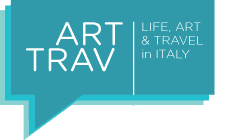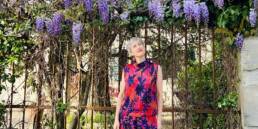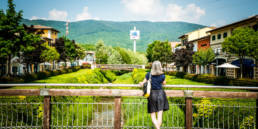This is the text of a talk that I am giving at 7pm on Monday July 6th at Florence Inn (Bagno a Ripoli FI). It is the introductory talk in an evening’s informal discussion of the same title. The “debate” is organized by FlorenceIN social network and The Florentine free press.

Those in attendance are invited to follow along on their iphones (arttrav uses an iphone wp plugin to make that easy). This text is slightly expanded and includes links by which you can follow up on some of the things mentioned only briefly. If you enjoyed something in particular or would like to comment or expand on something, you are again encouraged to write a comment on this post.
If you can’t make it to the talk but enjoy reading this, please participate by leaving comments!
First encounters
Last year I had the fortune of teaching art history at the University of Georgia Study Abroad program in Cortona. Like most study abroad programs, students come for one semester in Italy, which is three or four months. When they first arrive, they grapple with culture shock, they question why things are different here, and they sometimes complain about the lack of certain conveniences like being able to order coffee to take out in tall paper cups. In the first weeks, some of my favourite students worked hard to fit in, and asked me things based on their observations. They asked if it was okay to drink beer in the streets since that is in fact legal here but not at home; or if it was okay to go to a church service even if they’re not Catholic. Over time they figured it out and came to love many things about life in Italy, even perhaps prefering cappuccino standing at a bar instead of walking around with a gigantic cup from Starbucks.
A profound effect
Three months in Italy will have a profound effect on anyone, student or adult traveler. Most of the students I taught were artists, so aspects of their Italian experience were particularly evident in the art that they produced here and continue to produce at home. For example, AJ Weiss made an album of music in Italian inspired by Jovanotti (our school was literally his neighbour in Cortona). Jewelry artist Miriam Rowe created necklaces inspired by what she saw at local markets. The visiting professors also incorporated bits of Italy into their works; my colleague Katerina Burin saw beauty even in those small napkins in bars, which she reproduced in large scale prints.
Miriam is home in Georgia now and she recently posted a list on her blog: “Things I miss about Italy” from which I’m going to loosely quote. This includes:
- Fresh, locally-grown fruit and vegetables any time I want them, and paying next to nothing for it.
- Saying “ciao” all the time – it’s so easy.
- Being in places that were built before Jesus was born.
- Playing the “Look Like An Italian” game – which involves wearing dark colors, boots, and funky hair and seeing if people speak to me in Italian before they speak to me in English.
By wearing all black and walking in that unapproachable way of Italian women, Miriam was hoping to fit in, but was probably never mistaken for an Italian, just as in ten years here I seldom have been.
Mediating cultural exchange
So, When Laura asked me to come up with a theme for tonight’s debate, I thought of my own, as well as my students’, struggle to fit in to Italian culture. But I also thought of what I’ve come to love about life in North America and my desire to transfer some of those positive elements to life here in Italy.
The idea behind the title “Mediating Cultural Exchange” incorporates both the taking and the giving aspects that happen when an anglophone comes to Italy, or really in any case of two cultures meeting. This is an opportunity to confront one culture with another; to consider our norms from the point of view of an outsider; to weigh out differences and similarities; and perhaps to choose which aspects of our own culture we prefer to keep, and those that we wish to alter.
I do not wish tonight to offer a list of what’s better here or there. Rather, I’d like to briefly provide some examples of the positive ways that I see Anglophone and Florentine culture interacting. The first, the working world, will be expanded upon in the talks by Suzi, Nina, and Lynn. I will look at three manifestations of the American love for Italy: study abroad, volunteerism, and tourism. Given time limits I’ll have to just suggest a few statistics, names, and websites for further reading.
Study abroad
 Study abroad is considered essential preparation for work in a globalized world. Here are some interesting numbers:
Study abroad is considered essential preparation for work in a globalized world. Here are some interesting numbers:
- Italy is the number two destination for US study abroad students, with about 27,000 students (2006/7 data from IIE.org)
- AACUPI (Association of American College and University Programs in Italy) currently has 50 member programs in Tuscany alone, for about 8000 students per year, mostly in Florence.
Study abroad brings measurable benefits to the host country. There is direct revenue for Italian economy to the tune of 400 million euros per year (396,832,000.00 euros to be precise). Beyond this, there is indirect revenue of about 691M, which includes the extra tourists who visit young people here for the semester. Furthermore, study abroad also creates a degree of loyalty to Italy that tends to promote return visits by those people who had come here to study.

To quote directly from a report published by the AACUPI, study abroad creates “a context within which it is possible to develop real cultural exchange between academic tourists and Italian residents.” The British Institute is a perfect example of this since it serves both foreign and local populations. Some other examples include conversational language exchange between Italian and American young people, and art shows and symposia put on by various programs. Syracuse University in Florence has a permanent art exhibition space and has an annual art history symposium (in which I participated as a MA student in 1999). From its inception in 1974, UGA Cortona puts on a semestral “mostra” or art show of student work. This exchange can certainly be increased, which brings me to my next point…
Volunteerism
I knew as I started writing this talk that I would not have time to talk about volunteerism, so for the presentation I’m going to flash a slide on the screen and hope that you’ll look at the written version later. If you’re reading this from home, what I wanted to point out was that there are many examples of American associations that give back in some way to Florence. These include some of the larger study abroad programs, as well as other organizations.
I think it’s important to highlight how American study abroad programs contribute in a positive way to Florentine society in the light of recent tragedy and ridiculous behaviuor. Of schools that “give back”, the two biggies, Syracuse University and New York University, come to mind. Both of these have volunteer programs that get their students out and working in needy sectors of the community. In NYU’s community service program, students work alongside locals coaching sports, serving food at a church, etc.; SUF has volunteer as well as internship programs and also contributes to the arts in Florence, collaborating with the Maggio Musicale Fiorentino, putting on operas and translating childrens’ books. When I worked at UGA I was impressed with the program that puts UGA students into the local elementary school to teach art. These are examples from my own experience; I am sure that there are many more and invite you to post them in the comments section of this article.
Some organizations help bridge the gap between anglo and tuscan life, like the Tuscan American Association. And many give back in a substantial economic way to the art and culture of the city. The two of which I know are the Jane Fortune Foundation and the Friends of Florence. Both of these non-profit foundations fund and carry out restoration projects on important, or sometimes lesser known, works of art.
Cultural / Sustainable Tourism
As the study abroad numbers and volunteer associations demonstrate, Americans have always had a particular love of Florence, which shows up in tourism too. About 5 million american tourists come to italy each year which make up about 8.5% of the country’s visitors (source: enit.it). That is a great MASS of people – which contrasts with one of the latest buzzwords in the tourism industry: “sustainable tourism”. This can be defined basically as the opposite of “mass tourism”. The idea is to avoid having a negative impact on the country being visited. This is most often cited in relation to the impact of tourism on environments like rainforests, and less often considered in relation to Italian cities like Florence. A case in point is that neither the provincial nor regional official websites for tourism seem to address this topic, while it is those very organizations that ought to advise tourists on what they can do to be responsible visitors to our city.
What I’d call informed, cultural, or sustainable tourism is in some ways the adult counterpart of study abroad, but the onus of learning is on the self rather than on professors. You probably already participate in this trend if you research, and are sensible to, the social customs and histories of countries you visit.
Riding on the interest that Americans have for travel in Italy, some tour operators have developed sustainable options. For example, Context Travel offers small group seminars to introduce tourists to themes like the “Artisans of the Oltrarno”, or the “Ecology of the Venetian Lagoon”.
As a compliment to my work as a professor on study abroad programs, I like to think that I make a small contribution to “Informed Travel” with my online magazine, arttrav.com. I seek to provide information about art, travel, and life in Italy at a level of analysis more typical of university programs than of websites. So my short talk comes full circle: by posting arttrav articles on social networks like Facebook and Twitter, I have been able to keep in touch with some of my students who have returned to the States, like AJ and Miriam whom you met just minutes ago. In this way, while their direct cultural encounter has come to an end, I hope that I am extending the benefits of their Italy education by virtual means.
Sign up to receive future blog posts by email
Alexandra Korey
Alexandra Korey aka @arttrav on social media, is a Florence-based writer and digital consultant. Her blog, ArtTrav has been online since 2004.
Related Posts
December 31, 2023
How sewing saved my sabbatical
April 30, 2022




